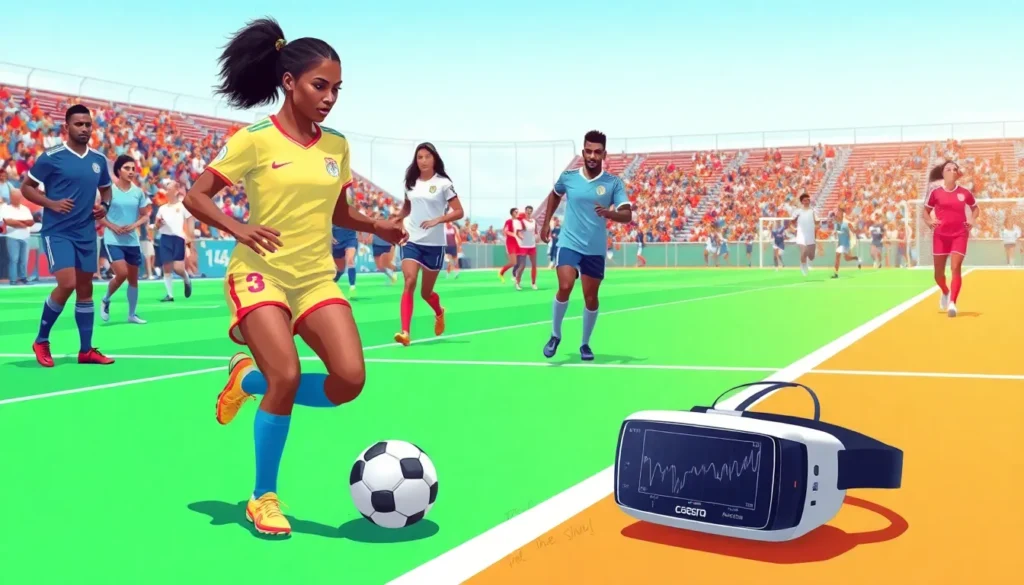As technology zooms ahead like a sprinter breaking the tape, the future of sports is shaping up to be as thrilling as a last-second buzzer beater. Imagine a world where athletes train with AI coaches that know their every move or where fans experience games through virtual reality, feeling the adrenaline rush without leaving their couch. It’s not just a dream; it’s the new playbook.
The Future Of Sports
The transformation of sports increasingly reflects technological integration and shifts in how fans and participants connect.
Technological Advancements
Athletes now leverage AI coaching for customized training regimens. Data analytics provide performance insights, enhancing skills and strategies. Wearable technologies monitor health metrics, thereby reducing injury risks. Virtual reality immerses players in realistic game scenarios for improved preparation. Augmented reality enriches fan interactions by superimposing stats and player info during live games. These advancements create dynamic environments, reshaping athlete preparation and performance.
Changes in Audience Engagement
Fans experience a revolution in sports consumption through enhanced digital platforms. Streaming services offer personalized viewing options, creating tailored content experiences. Social media connects fans directly to their favorite athletes, fostering community engagement. Interactive applications allow users to vote on game events, amplifying their participation. Rich multimedia storytelling captivates audiences, transitioning traditional spectators into active participants. These developments signify a new era in sports engagement, aligning with contemporary audience expectations.
The Role of Technology in The Future of Sports

Technology fundamentally reshapes the sports landscape, impacting both athletes and fans. Innovations such as wearable devices and immersive virtual experiences redefine engagement in the sporting world.
Wearable Devices and Analytics
Wearable devices track vital health metrics, enabling athletes to optimize performance. These technologies continuously monitor heart rates, oxygen levels, and movement patterns. Coaches can analyze collected data to customize training regimens that target specific needs. Injury prevention also benefits from informed insights, as real-time feedback allows quick adjustments. Athletes using smart sensors gain a competitive edge by leveraging precise, actionable information.
Virtual Reality and Augmented Reality
Virtual reality creates immersive training environments that simulate realistic game situations. Athletes enhance their skills through lifelike scenarios that improve decision-making under pressure. Augmented reality enriches spectator experiences by displaying real-time statistics during live events. Fans engaging with AR applications receive tailored content, deepening their connection to the game. Both technologies foster innovative ways for athletes and fans to interact, ensuring sports remain vibrant and accessible in the digital age.
Emerging Trends in Sports
Innovative shifts are redefining sports, introducing new dimensions that enhance both athlete performance and fan engagement.
Esports and Competitive Gaming
Esports are growing into a major segment of the sports industry. Gamers compete in tournaments that draw millions of viewers, underscoring the shift toward digital competition. Various platforms now host live events, allowing fans to experience gaming action in real time. Professional gamers often receive sponsorships and sign contracts similar to traditional athletes, reflecting the professionalization of competitive gaming. Increased investment benefits teams and players, driving the growth of esports leagues globally. Social media presence plays a critical role, connecting fans directly with their favorite gamers, facilitating community engagement that transcends traditional sports boundaries.
Sustainability and Eco-Friendly Practices
Sustainability is becoming a priority within the sports sector. Organizations are adopting eco-friendly practices to reduce their environmental impact. Some stadiums now feature solar panels, energy-efficient lighting, and water conservation systems. Major sporting events are increasingly focusing on zero-waste initiatives, with recycling and composting programs in place. Partnerships with environmental organizations highlight commitments to sustainability and conservation. Through these initiatives, sports entities not only foster positive community relationships but also inspire fans to embrace eco-conscious lifestyles. This shift toward sustainability enhances the overall experience while promoting a healthier planet.
The Impact of Global Events
Global events significantly shape the landscape of sports, altering how athletes compete and fans engage.
Influence of the Pandemic on Sports
The pandemic disrupted sports globally, forcing leagues to cancel seasons and postpone events. Athletes adapted to new protocols, including health screenings and limited audience participation. Virtual formats flourished during this time, allowing fans to engage through online platforms and social media. Major sporting events like the Tokyo Olympics embraced strict safety measures, demonstrating resilience in the face of unprecedented challenges. Data indicates that viewership numbers rebounded quickly as leagues established safe environments. This shift also spotlighted player health, emphasizing the importance of mental well-being alongside physical health.
Preparing for Future Crises
Sports organizations now prioritize crisis management to ensure sustainability. Developing contingency plans became essential as leagues learned from past disruptions. Technology plays a crucial role in enhancing communication between teams and stakeholders. Innovations in real-time data tracking promote transparency and quick decision-making. Increased collaboration with health authorities sets a precedent for managing potential outbreaks. In addition, flexible scheduling practices improve adaptability to change. By anticipating challenges, sports entities can maintain operations and preserve fan engagement during crises.
Conclusion
The future of sports is undeniably bright as technology continues to drive innovation across the industry. Athletes are set to benefit from personalized training through AI while fans will enjoy immersive experiences that deepen their connection to the games they love.
As esports gain traction and sustainability becomes a priority, the landscape will evolve further. The resilience shown during recent global challenges highlights the adaptability of sports organizations. By embracing new technologies and prioritizing fan engagement, the sports world is on the brink of a transformative era that promises to redefine how everyone experiences athletic competition.

